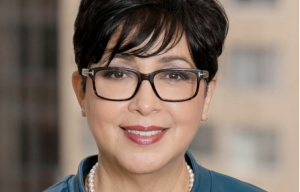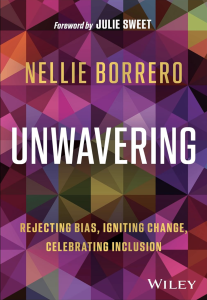If you haven’t heard of Nellie Borrero (above), then that’s OK. You can’t know everyone.
But in the world of diversity and inclusion, Borrero is something of a figurehead.
Borrero is an Accenture veteran through and through. This year she celebrates 40 years with the business. But for thirty of those (since 1994), she’s been a diversity director either nationally or globally for the firm.
More remarkable than this though, she became one when diversity was barely a word most businesses even uttered let alone actually understood.
Today, she’s officially Accenture’s MD, senior strategic advisor (global inclusion and diversity), and she’s marking her three-decades beating the diversity drum by publishing her first book – “Unwavering: Rejecting Bias, Igniting Change, Celebrating Inclusion.”
Unapologetically a book about her reflections as a Latina woman navigating the sometimes glacially slow evolution of DEI, Borrero shares how she’s taken Accenture – a business that she describes as being dominated by white men in the 1980s – to one that today sees it ranked as the #1 most inclusive and diverse workplace by Refinitiv (for four of the last six years), and which also sees it as the top-scoring company on the Bloomberg Gender-Equality Index for the past two years.
Its success, however, that hasn’t exactly come overnight.
She’s had to fight numerous battles along the way. But at a time when DEI now seems to be facing something of a backlash (with the Supreme Court recently ruling that positive discrimination in hiring was illegal), the status of DEI in organizations appears to have reached a critical point in time.
Having reached new levels of awareness, are the gains and successes that Borrero and her DEI peers have fought so hard to get are now in danger of being replaced by a different diversity narrative – one that is arguably less inclusive.
So what does the future hold?
To mark her new book coming out, TLNT spoke exclusively to Borrero, to hear first hand about her reflections on past advancements, but also (and crucially), what she thinks the future looks like for DEI going forward:

Q: To say your DEI journey has a long one would be an understatement. Tell me how if all began for you, and why diversity became such a mission for you.
A: “I would have to say, that diversity is something that I – as a Latina – have had to deal with in some form all my life. In the workplace though, was probably when it became most apparent to me. Back in the 1980s, the workplace was an entirely different place to what it is now. The way I sounded was different, and I always thought people were judging my level of intelligence based on that. I remember thinking I needed to move people on from how I sounded to how I performed. To a large degree, my diversity journey was personal. I didn’t feel the culture I was part of allowed me to thrive. The word diversity wasn’t commonplace at the time, but I started to take an interest in how the business could focus on the female agenda – more as a way of retaining people. I think that the business knew it had untapped talent, and to Accenture’s credit, it eventually decided that a role I was doing part time needed a full-time commitment, which was when I became its first diversity director.”
Q: How difficult was it establishing a diversity agenda at that time?
A: “I definitely wouldn’t say it was easy! Luckily, I had an influential leader supporting me, which was great, because I knew that going to the ‘lower level’ executives was not going to give me the support I needed. I simply showed up, asked for help, and talked about how we could showcase this from a brand perspective. I decided that the only way I was doing to get traction was to do my research, and thoroughly present the benefits of diversity with facts. There was a real need to present the business case. Yes, I was ultimately trying to affect culture change, but really I knew I had to bring the leadership with me first. Although there was an LGBT group internally, I also decided to be an advocate for gay employees – this was not an easy conversation to be having in the 1990s – and I also felt we needed to move things beyond ethnicity to gender too. I basically decided I wanted to understand the total human experience.”
Q: How do you reflect on where things have come now?
A: “I started off by advocating for ways in which we could ‘include’ people, and to that extent, where we’ve come from is a world away from where Accenture was. Are we in a better place now? Yes, of course. But is it a more complex reality now as well – yes! We are far better represented now than we’ve ever been, but I also observe that that there are things that we – Accenture – have achieved that are also being challenged now. My thoughts however, are that brands need to position diversity a business imperative. And brands that understand this, still need to focus aggressively on DEI. I am unwavering about this.”
Q: There are still things that need to change. You say that people still have to ‘code-switch’ at work. What do you mean by this?
A: “For people of color, this is a very real thing still – like it was with me. It’s where people who go to a place (such as a workplace), feel they have to change how they speak to ‘fit in’ because they are one of the few, and they have to figure out a new way to behave. Think about it though – this whole process is draining of people’s energies. People want to be in settings where people ‘get them’ and where they are celebrated for the different lived experience that they have. When people feel they are in settings with shared lived experiences, they feel more welcomed, and feel more engaged. So I’m still beating the drum about the need to educate people about our biases.”
Q: “Do you think diversity training the best way to move the diversity dial, or is it still seen as box-ticking?
A: “I see that people go through diversity training, but at the same time, attendees are frightened to say anything for fear of offending people. So in some cases, diversity training actually heightens people’s anxieties. But to this I would say that as long as the training is done in the right spirit, then it’s fine – that is, we have a responsibility to educate people about things that may trigger others. Training is bad when it implies that ‘if you don’t get this, you must be a bad person.’ I think all CHROs need to convey the fact that everyone has biases, but at least we can be aware of them, and do some course correcting if it’s impacting people. In other words, it’s all about having conversations.”
Q: Do you think the Bud Light debacle have frightened companies off from some areas of diversity?
A: “I think they took a risk, but I think we also need to take a moment to pause about this. We have a generation that now has an ‘expectation’ that the companies they work for will100% support diversity and inclusion. I hope companies will still take risks because it’s only a concern if they stop trying.”
Q: Are you positive about the future of DEI – especially if more Gen Z will be entering the workplace?
A: “I hope so!! I do believe we are in good hands actually. Young people have such a great way of looking at the world, and at inclusion more generally. This really does make me have so much hope. This generation has been exposed to so much that they see a different world now.”
Q: Does anything worry you about the future of diversity?
A: “The only things I get concerned about are external policies. I’m more concerned about this than companies that ‘don’t get’ diversity’. I’ve had conversations where I agree that we now have to assess if certain policies are working. But this is the right thing to do – as long as diversity isn’t pulled back on completely. We all have a responsibility to assess programs, while still committing to DEI.”
Q: What’s next for you?
A: “I’m not retiring yet if that’s what you’re asking! For me, what I’ve wanted to do is use my book to showcase the good, the bad and the ugly around diversity. I’ve wanted to also show that its not an easy ride, and how marginalization still shows up. I want diversity to step out of the margins and go to the center more. It’s a book that looks at how companies ‘show up’ and what they need to do to shout about the things that matter to them. I still want to get the diversity message out, and to coach and mentor people in this area. In the context of needing to have more courageous conversations about diversity, I think we need what I have written more than ever.”
Unwavering: Rejecting Bias, Igniting Change, Celebrating Inclusion is out now.
Click here to order your copy.

